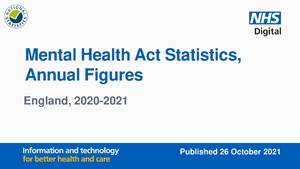NHS Digital, 'Mental Health Act Statistics, Annual Figures - 2020-21' (26/10/21)
MHA statistics "This publication contains the official statistics about uses of the Mental Health Act in England during 2020-21."
From NHS Digital website
Publication Date: 26 Oct 2021
Geographic Coverage: England
Geographical Granularity: Mental Health Trusts, NHS Trusts, Independent Sector Health Care Providers, Hospital Trusts, Sustainability and Transformation Partnerships
Date Range: 01 Apr 2014 [presumably meant to be 2020] to 31 Mar 2021
Update
Mental Health Act Statistics, Annual Figures 2020-21: Data Tables Update
This publication has been updated since the original publication on 26th October 2021 to reflect the correction of a data error discovered in Data Table 1e of the Mental Health Act Statistics, Annual Figures 2020-21: Data Tables. The error which transposed the counts of male and female detentions (rows 25 and 26 and columns H and I in Table 1e) has now been fixed and a new Data Table file re-issued.
23 November 2021 10:45 AM
Summary
This publication contains the official statistics about uses of the Mental Health Act(1) ('the Act') in England during 2020-21.
Under the Act, people with a mental disorder may be formally detained in hospital (or 'sectioned') in the interests of their own health or safety, or for the protection of other people. They can also be treated in the community but subject to recall to hospital for assessment and/or treatment under a Community Treatment Order (CTO).
In 2016-17, the way we source and produce these statistics changed. Previously these statistics were produced from the KP90 aggregate data collection. They are now primarily produced from the Mental Health Services Data Set (MHSDS). The MHSDS provides a much richer data source for these statistics, allowing for new insights into uses of the Act.
However, some providers that make use of the Act are not yet submitting data to the MHSDS, or submitting incomplete data. Improvements in data quality have been made over the past year. NHS Digital is working with partners to ensure that all providers are submitting complete data and this publication includes guidance on interpreting these statistics.
Please note: This publication covers the 2020-21 reporting year and, as such, it is likely the impact of COVID-19 may be evident as the national lockdown began on 23 March 2020. The time series data for people subject to detention does show a decrease in people subject to detention in March 2021 so the context of COVID-19 should be kept in mind when using and interpreting these statistics.
Footnotes
(1) The Mental Health Act 1983 as amended by the Mental Health Act 2007 and other legislation.
In 2020-21:
- 53,239 new detentions under the Mental Health Act were recorded, but the overall national totals will be higher. Not all providers submitted data, and some submitted incomplete data. Trend comparisons are also affected by changes in data quality. For the subset of providers that submitted good quality detentions data in each of the last three years, we estimate there was an increase in detentions of 4.5 per cent from last year. Further information is provided in the Background Data Quality Report.
- Comparisons can still be made between groups of people using population-based rates, even though the rates shown are based on incomplete data. Known detention rates were higher for males (94.8 per 100,000 population) than females (87.9 per 100,000 population).
- Amongst adults, detention rates tend to decline with age. Known detention rates for the 18 to 34 age group (142.5 detentions per 100,000 population) were around 56% higher than for those aged 65+ (91.6 per 100,000 population).
- Amongst the five broad ethnic groups, known rates of detention for the ‘Black or Black British’ group (343.5 detentions per 100,000 population) were over four times those of the White group (74.7 per 100,000 population).
- Known rates of Community Treatment Order (CTO) use for males (13.2 per 100,000 population) were higher than the rate for females (8.3 per 100,000 population). Across age groups, those aged 35 to 49 had the highest rate of CTO use (18.3 known uses per 100,000 population compared to 10.7 uses per 100,000 population for all age groups).
- Amongst broad ethnic groups, known rates of CTO use for the ‘Black or Black British’ group (78.9 uses per 100,000 population) were over ten times the rate for the White group (7.8 uses per 100,000 population).
External links
The NHS Digital website has links to the following documents:†
- Mental Health Act Statistics, Annual Figures 2020-21: Summary Report
- Mental Health Act Statistics, Annual Figures 2020-21: Easy Read
- Mental Health Act Statistics, Annual Figures 2020-21: Data Tables
- Mental Health Act Statistics, Annual Figures 2021-21: Background Data Quality Report
- Mental Health Act Statistics, Annual Figures 2020-21: Machine Readable Data File
- Mental Health Act Statistics, Annual Figures 2020-21: Length of Detention Machine
- Mental Health Act Statistics, Annual Figures 2020-21: Metadata
- Pre-Release Access List
Download: URL
Type: Statistics🔍
Title: Mental Health Act Statistics, Annual Figures - 2020-21
Organisation: NHS Digital🔍
Date: 26/10/21🔍
What links here:
